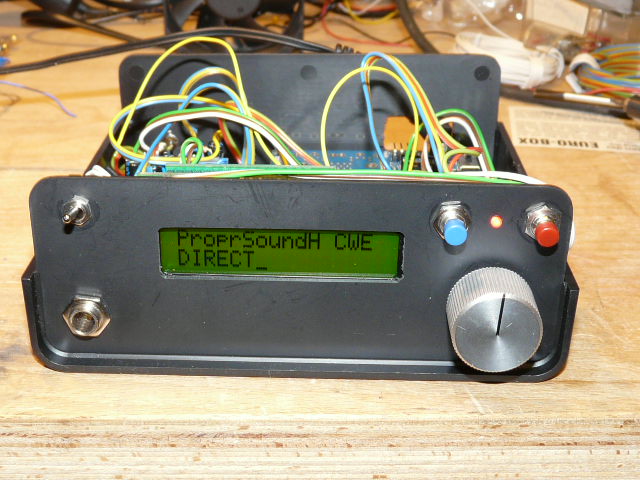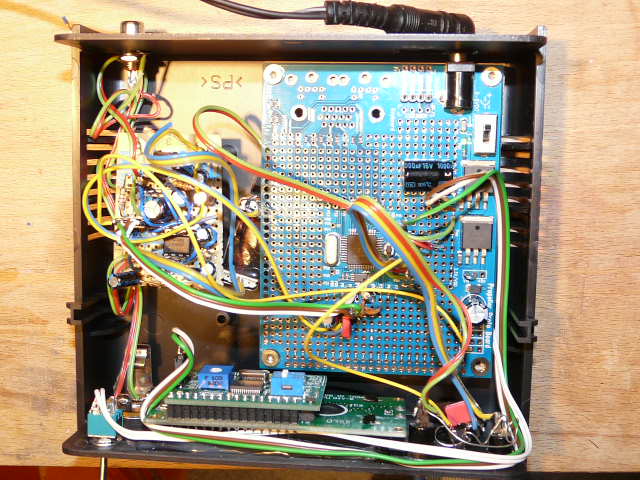ProprSound - Sound Processor for Guitars uses a Propeller and PropBasic
Hi all,
the idea of this was born, when I made experiments with simple analogue·circuits that generate distortion for cool sounds of my electric guitar. I thought, that the sound quality is not allways the key question and it must be interesting to influence sound with software. After I then discovered that there was now PropBasic, I had to start....
ProprSound:
Uses the Propeller chip and its onboard ressources, ADC, DAC (sigma delta), cogs and ram. It is built with a Proto board and a small second board with analogue amplifyers.
PropBasic and its speed has made it possible to do·that without any assembler, because·it is fast enough to process the sound between the samples.
A parallax 2-line serial lcd is the display, two switches and a poti form the user interface. The main cog for the user interface software runs with LMM.
As the ADC/DAC is only 12bit at 19kHz sample rate, the main issue has been signal to noise ratio. The following measures helped here:
1. For clean sound, the analogue signal is only preamplified and directly led to the output, without any digital processing at all -boring, but effective. LCD is static then and not updated, to give no noise.
2. The preamplifyer has variable gain, controlled by a FET. A compressor routine of the propeller generates an analogue voltage, that controlles the gain. So the valuable 12 bits resolution·are utilisized more fully.
3. Borrowed from the singing monks: Oversampling DAC with added white noise -dither- avoids strange noises.
((4. A switching power supply gave some awful buzzing, which was no more there, after I changed to·different mains adaptor. I have done this not until after all the capacitors, which you can see on the photograph did not help....))
ADC, Compressor, Distortion, Echo (Delay), Reverb,· Oversampling DAC with dither
are implemented at the moment and processed in this sequence.
There are 10 parametersets installed, which can be recalled and edided.
In the source code file there are additional comments.
In the zip there is a sound example.
Have fun,
Christof

the idea of this was born, when I made experiments with simple analogue·circuits that generate distortion for cool sounds of my electric guitar. I thought, that the sound quality is not allways the key question and it must be interesting to influence sound with software. After I then discovered that there was now PropBasic, I had to start....
ProprSound:
Uses the Propeller chip and its onboard ressources, ADC, DAC (sigma delta), cogs and ram. It is built with a Proto board and a small second board with analogue amplifyers.
PropBasic and its speed has made it possible to do·that without any assembler, because·it is fast enough to process the sound between the samples.
A parallax 2-line serial lcd is the display, two switches and a poti form the user interface. The main cog for the user interface software runs with LMM.
As the ADC/DAC is only 12bit at 19kHz sample rate, the main issue has been signal to noise ratio. The following measures helped here:
1. For clean sound, the analogue signal is only preamplified and directly led to the output, without any digital processing at all -boring, but effective. LCD is static then and not updated, to give no noise.
2. The preamplifyer has variable gain, controlled by a FET. A compressor routine of the propeller generates an analogue voltage, that controlles the gain. So the valuable 12 bits resolution·are utilisized more fully.
3. Borrowed from the singing monks: Oversampling DAC with added white noise -dither- avoids strange noises.
((4. A switching power supply gave some awful buzzing, which was no more there, after I changed to·different mains adaptor. I have done this not until after all the capacitors, which you can see on the photograph did not help....))
ADC, Compressor, Distortion, Echo (Delay), Reverb,· Oversampling DAC with dither
are implemented at the moment and processed in this sequence.
There are 10 parametersets installed, which can be recalled and edided.
In the source code file there are additional comments.
In the zip there is a sound example.
Have fun,
Christof





